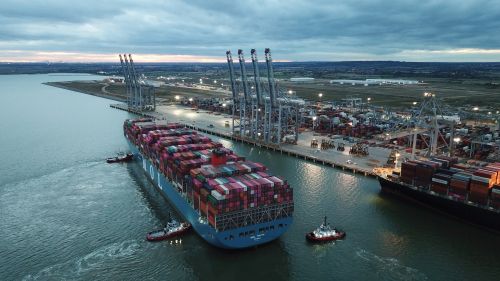Archives
Business, Feature, Freight News, Logistics, Sea
A new dawn rises for Freeports
[ February 5, 2021 // Chris ]Ports throughout the UK have been submitting their bids for Freeport status, ahead of the Government’s deadline on 5 February. A decision by the Treasury on which ports will qualify is expected in the Spring.
They include the Thames Freeport consortium which has lodged a planfor a digitally-linked economic zone connecting Ford’s Dagenham engine plant, London Gateway (pictured below) and Tilbury ports and other large employment areas
Government’s estuary envoy and chair of the Thames Estuary Growth Board (TEGB), Kate Willard said: “The Thames Estuary will play a major role in the UK’s post-Covid, post-transition recovery – and a freeport is at the heart of our plans. It would galvanise green growth and help to level-up some of the UK’s most deprived areas. It would ensure the Estuary is able to capitalise on its existing strength as a magnet for growth through commerce, creativity and prosperity. It would bolster our ambition to create the greenest estuary in the world and help achieve national net zero targets. We fully support the Thames Freeport bid and we’re confident that our partners will deliver an irresistible pitch to Government.”
The TEGB is to send a letter of support to the Chancellor pressing the case for a Thames Freeport on behalf of a coalition of industrial, business and political interests from across the Thames Estuary.
Stuart Wallace, chief operating officer at Tilbury owner, Forth Ports, added: “The Port of Tilbury has a track record of investing for the future – from building Britain’s newest port, Tilbury2, to a sustained focus on innovation, alongside the construction sector that allows us to build back better, green logistics and clean energy production.
“Exporters will be able to take advantage of Thames Freeport’s connectivity to every continent, our proven track-and-trace technology and modern training facilities to ensure the Thames Estuary remains a magnet for investment across the aerospace, automotive and the many complex manufacturing and processing businesses along this important industrial corridor.”
The Hutchison-owned Felixstowe (main picture) and Harwich ports meanwhile pushed for their Freeport East concept, which they said could create 13,500 jobs in the region.
Freeport East is a partnership of business and local government and has also been backed by both the New Anglia and South East Local Enterprise Partnerships.
If freeport status is granted to the area, the bid estimates 13,500 new jobs could be created in the area, while over the next five years Freeport East would attract more than £500million of investment – while providing a £650m boost to the UK economy.
Chairman of the Project Board, George Kieffer, said: “Just as the sun rises in our region before it spreads across the UK, so Britain’s future starts at Freeport East. The key ports of Harwich and Felixstowe are already critical for overseas trade; but with a reliable supply of sites nearby to host innovation hubs, attract new businesses, and the base infrastructure which underpins these, Freeport East is clearly the Government’s best choice for this designation.
“This is a golden opportunity for our towns, regions, and ultimately our country to prosper.”
Executive Director of Hutchison Ports and managing director of Hutchison Ports Europe, Clemence Cheng, added: “Freeport East is uniquely placed to deliver on the Government’s objectives for Freeports, to provide hubs for global trade and investment, promote regeneration and create hotbeds for innovation. We connect exporters across the UK with markets worldwide and the economic benefits of our truly global Freeport will be felt in all regions.
“Working with our local councils, LEPs, partners and innovators we will deliver a green energy hub that will help deliver net-zero transport systems and complement sustainable developments in other regions.”
The UK Major Ports Group said: “A significant number of strong freeports bids have been submitted by the Government’s deadline. We understand that this includes bids involving major seaport operators in regions such as the Thames, Kent, Suffolk, the Humber, Tees, Tyne and Northumberland, Cumbria, Merseyside, the Avon and Somerset and the Solent.
Chief executive Tim Morris, said: “It looks like bidders have risen to the challenge issued by the Government to deliver bids that offer real potential for stronger global gateways for trade, to boost prosperity and opportunity for coastal communities and that drive innovation. They also demonstrate commitment to high standards and growing social value. The challenge is now back to the Government to assess fairly and in a considered manner a significant number of strong but quite different bids.”
The British Ports Association said that it was aware of approximately 35 organisations or consortia that have expressed an interest in bidding, publicly or privately, including 27 in England.
The industry has welcomed the recognition of governments across the UK that ports have an important role to play in industrial policy, supporting innovation and prosperity in coastal communities and beyond. But whilst welcoming the focus from government, the BPA has warned about how intervention in a competitive market could have unintended consequences. Since major reforms to the industry thirty years ago, the industry has operated entirely independently of government in terms of its funding and governance and this has brought huge benefits: ports invest hundreds of millions of private capital every year in infrastructure and contribute £2bn a year to the Exchequer.

Tags: Hutchison Ports; Felixstowe; Harwich; Forth Ports; London Gateway; Tilbury











